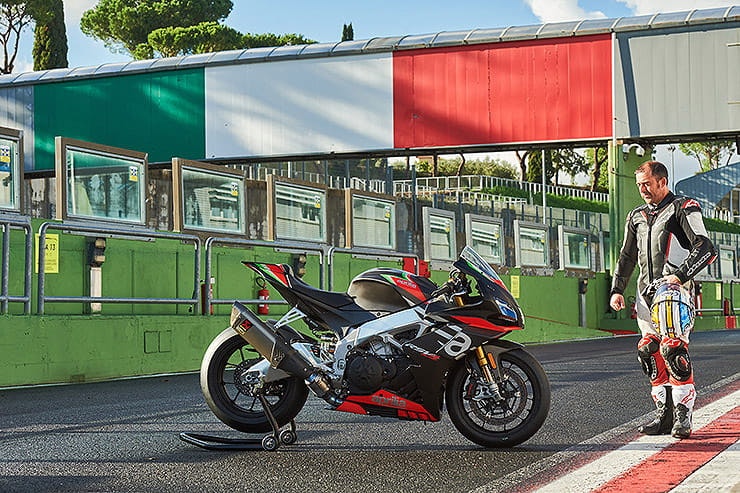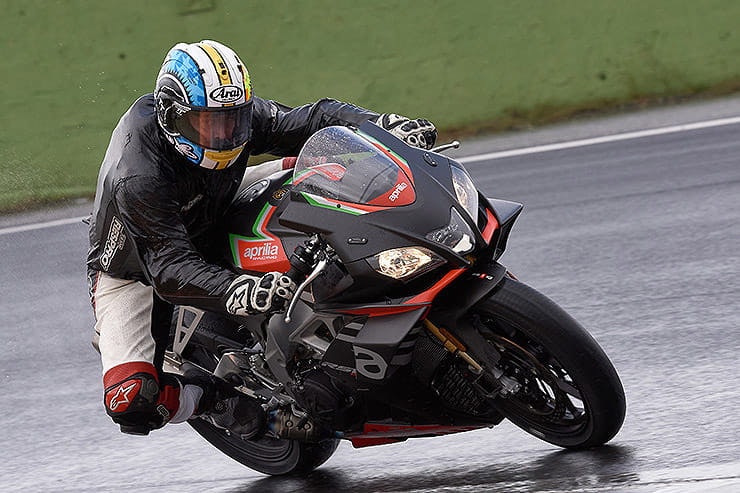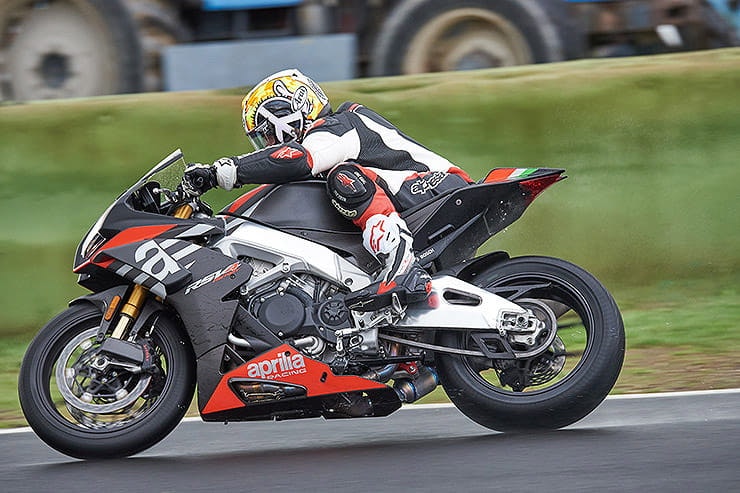Aprilia RSV4 1100 Factory (2020) - Review
BikeSocial Road Tester
26.10.2020
214bhp in the wet should be frightening, like stepping into a bull ring for the first time and running around in a red cape. That much power and force should be overwhelming in the wet – but isn’t. The new 2020 Aprilia RSV4 Factory 1100 is the most advanced RSV to leave the Aprilia factory, and is now fitted with the latest electronic Smart EC 2.0 Öhlins suspension and steering damper, and alongside clever rider aids makes this supersonic superbike usable in the wet and far easier to set up, too. Its semi-active suspension now has three ‘active’ modes and three ‘static’ modes, which are electronically adjustable from the buttons on the left bar.
You could argue Aprilia are a little late to the game given that the major manufacturers already have electronic semi-active suspension but, to quote Aprilia directly, “We would never use semi-active suspension until the stopwatch demonstrated an improvement in terms of lap times. That time has come. After two years of development in close contact with Öhlins technicians and thanks also to experience gained with the Tuono V4 1100 Factory, semi-active suspension now features on the top-of-the-range RSV4 1100 Factory.” Aprilia have extensively tested the new Öhlins electronic suspension at tracks like Imola and Mugello, and are claiming the new RSV4 1100 Factory is half a second faster.
214bhp, 177kg dry… the most advanced Aprilia RSV4 of all time, I was like a kid on Christmas Eve and couldn’t wait to try out the new model. We headed to a very wet Vallelunga race track just outside Rome in Italy to put the new RSV4 1100 Factory through its paces. If it worked in the wet, I reasoned, then it’s sure to work in the dry.
Handing, chassis
Electronics and rider aids
Engine strength and noise
Dash is a little less glamorous compared to the competition
Can’t independently change the engine brake assist
It was raining
2020 Aprilia RSV4 Factory - Price £23,399
Aprilia are slotting the new RSV4 factory right into the middle of the pricing war, making it a fraction cheaper than Honda’s semi active Fireblade SP (£23,495) and over a grand cheaper than their closest rival, which is arguably Ducati’s Panigale V4S (£24,795). Interestingly the previous V4 1100 Factory, with conventional Öhlins suspension was listed at £22,399, so you’re only paying a £1000 for the clever electronic suspension. Both Kawasaki’s ZX-10SE and Yamaha’s R1M come with semi-active suspension and are cheaper again; the Yamaha at £21,999 and the Kawasaki at only £19,149.
Power and torque
When did 200bhp become normal? These days, if you haven’t got over 200bhp you’re effectively bringing a knife to a gun fight! The V4 remains unchanged for 2020, which means 214bhp @ 13,200rpm and 90ftlb at 11,000rpm. At the start of 2019, the RSV4 was upped in capacity from 1000cc to 1077cc by keeping the stroke the same but increasing the bore from 78mm to 81mm, and although power remains the same on the ‘new’ model it’s still hugely impressive.
It’s not a one trick pony either; torque from the V4 is stunning an, on paper, its 90ftlb blows away the Japanese competition and is only beaten by the slightly larger Ducati (Aprilia: 1077cc, Panigale: 1103cc) with a quoted 91.5ftlb of torque.
Engine, gearbox and exhaust
The team that designed the fly-by-wire fuelling deserve a huge bonus this Christmas, because it’s perfect. I recently rode the new 1100 Tuono on track and couldn’t praise the fuelling enough, and it’s the same story with the new RSV4 Factory. It’s so precise, yet isn’t snatchy, and smoother than a professional wet shave. There isn’t a trace of lag, you’re in direct control of the bike and have a perfect connection. The gearbox, combined with the up and down quickshifter is, again, perfect. The engineers must be immensely proud of their work, and rightly so.
In wet and tricky conditions this is what you require: immaculate fuelling and throttle response that allow you to search for grip, and quick gear changes to moderate and optimise the force to the rear tyre. It’s perfect.
The cherry on the top of this perfect cake is a road legal titanium Akrapovic exhaust that sounds so sweet and is arguably makes the 2020 RSV4 the best sounding production bike of the moment. I’m unsure how Aprilia have managed to get it passed the Euro regulators, but it does sound good, even at low revs.
It’s not just fuelling, because the engine is a peach. The 65-degree V4 provides a lovely harmony between usable torque in the low and mid-range and a screaming over-run of power that eventually hits the rev limiter at 13,600rpm. On test, in heavy rain, I simply short-shifted to give the rear full racing-wet an easier time, but in more favourable conditions when the rain stopped I let it scream, only changing gear when the rev limiter lights illuminated, logging 165mph down the relatively short back straight, even in the wet.
There are three engine modes to chose from: Rain Sport and Track. Despite the rain, we still opted for the Sport mode, as the Rain mode is for wet riding on standard tyres, and we were using full race wets. Each of the three maps gives full power but changes the engine character and the power delivery, they also change the percentage of engine braking, which is specific to each map.
2020 Aprilia RSV4 1100 Factory Economy
As the engine has remained unchanged, and the weight and aero package, with the same indefinable wings, is the same, fuel economy and range should match the previous model’s 40mpg-ish during normal riding. The fuel tank is 18.5 litres, which is decently generous in this superbike category, and should give a range of 160 miles-plus to a tank, though in the real world you’re going to start searching for fuel around 130 miles. On track these figures will obviously be vastly reduced.
Handling, suspension chassis and weight
This is where it gets interesting. Now with the electronic Smart EC 2.0 Öhlins suspension and steering damper, you have three ‘active’ options – A1, A2 and A3 – and three ‘manual’ options – M1, M2 and M3. Active means the suspension is acting according to the road and riding, and manual is more like conventional suspension. A1 is developed for slick tyres, obviously on a racetrack, which should, surface-wise, be relatively smooth. A2 is for race or track day tyres, again on track, but now the track is a little uneven, and, finally, A3 allows more movement for the road on road tyres. The manual modes are similar but not semi-active. The modes within Active and Manual are not fixed and can be fine-tuned to the rider’s weight and skill, weather conditions, track, etc. The Öhlins steering damper is also now managed electronically.
When you come to fine tuning the suspension, Aprilia have simplified the process, meaning you don’t need to be an Öhlin’s technician to get the optimum setting. Everything is displayed via a 4.3-inch full-colour dash using the buttons the left bar. But Aprilia don’t use words like compression; instead you have the option to increase or decrease brake support, or reduce or increase rear support on acceleration. You can even add or reduce cornering support. All very clever and designed to be easy to use.
For most of the test I opted for A2: track use with race tyres. Yes, it was wet, but grip was okay and Vallelunga is a flat and relatively smooth race track. On the RSV4 I instantly felt at home. Some taller and larger riders have remarked on the small dimensions of the RSV, but I’ve always found it roomy enough on the road, and it feels like race bike with fairings on track. As soon as you leave pit lane, you’re boosted in confidence by that perfect fuelling, which means on pre-heated wet race tyres you push on from the off.
Sometimes electronic suspension can take away a chassis’ natural feedback, instead you rely on the suspension and tyres rather than feel the level of grip, but not so the Aprilia. I’d never ridden Valleunga previously, and soon discovered different sectors of the track have varying levels of grip, which change several times during the 2.5mile lap. But after only a handful of laps I’d worked this out, and this was down to the excellent feedback via the Smart EC-2 Öhlins suspension. Some corners where taken with knee down confidence, others not so.
It was the same result in heavy braking and acceleration. Some lines had more grip than others, and again the Öhlins suspension allowed me to feel for the grip available. I could brake later and later as the conditions improved, get on the power slightly earlier, feel the rear wet tyre take the load and smoothly, with precise fuelling, start accelerating. The chassis is excellent, you can make mistakes and bring it back to a tighter line without any complaints. Obviously in the wet I couldn’t push as hard as in the dry, but the data showed that towards to end of the day when the rain stopped I achieved a lean angle of 45 degrees on those wets, and always felt relatively safe, thanks to the feedback the chassis was giving me. If a bike works so well in the wet, and the previous models have always cut it on track, then I can safely assume the new RSV4 Factory will share the same impressive trait.
Brakes
In 2019 Aprilia uprated the Brembo brakes from the old M50 radial calipers to the new Stylema items, to put the RSV on-par with the competition. The braking set-up remains unchanged. There are three levels of ABS: level 1 with conventional ABS on the front and no ABS on the rear, level 2 with corning ABS front and back with rear wheel lift intervention, and level 3 with corning ABS front and back and rear wheel lift intervention, which is more road specific.
In the wet I opted for level 1 and was immediately impressed by the feedback and lack of intrusiveness. On par with the other very clever rider aids, you can’t ‘feel’ the system working, there is no juddering or anything similar. Only in extreme situations in very slippery conditions did I feel the system take over, saving me from locking up the front tyre, which would have resulted in a off. Again, we can’t push the brakes to the absolute limit in the wet, but so far and based on the previous model they should be faultless.
2020 Aprilia RSV4 1100 Factory Rider aids and extra equipment/accessories
As you’d expect on a £23,399 Aprilia superbike the list of rider aids is huge. You have the forementioned rider modes, Race, Track and Sport, which give full power in each mode and simply change the engine character, responsiveness and engine brake assist. You also have the braking modes mentioned above. Additionally, eight-stage traction control, simple to change via the thumb and finger toggle on the left bar, is easily altered on the fly and can also be deactivated. There’s more: AWC is a three level Aprilia Wheelie Control; ALC is Aprilia Launch Control; AQS is Aprilia Quick Shift; there’s a pit lane limiter, APL, and even cruise control, ACC.
Again, like the fuelling, the rider aids can’t be complimented enough – they are first class. To make a 214bhp Superbike usable and safe in the wet takes very clever electronics and rider aids. I’ve ridden the previous model and the naked Tuono, which has very similar electronics, and both are exceptional. The only downside, and this is me being very picky, is the engine brake assist, which prevents the rear from locking up but, unlike other manufacturers’ similar systems, can’t be changed independently. In fact, it can only be changed via the three engine modes.
As you’d expect, the majority of the accessories are created for the track, not many practical tank bags here... We had the front brake carbon air vents (£257) fitted, which are designed to cool down the calipers and maintain a consistent braking performance. I’m unsure they are needed on a road bike, especially in the wet, but they do look very trick. As you’d also expect, a full racing exhaust is available from Akrapovic, which requires a dedicated map supplied by Aprilia Racing. There is also a racing ECU designed for track use and to work with the dedicated racing exhaust. Cosmetically there are a host of carbon extras to lighten the bike further and give even greater visual impact.
RIVALS
2020 Aprilia RSV4 1100 Factory Verdict
It’s really hard to find fault with Aprilia’s new RSV4 1100 Factory. I’m struggling to find a negative, aside from the horrendous track conditions at its launch and a rather small dash – but even that is still clear and easy to read. All I have is superlatives and praise for the revamped 2020 model.
The fuelling is perfect; the gearchange, the quick-shifter, engine performance and sound, are impossible to fault. On test, the new Öhlins electronic suspension gave great feedback and rider confidence, and it’s easy to adjust and personalise, too. The electronic rider aids are some of the very best, ditto the chassis, and to top of it all off the RSV4 looks stunning. Hopefully, our initial impressions translate to the road. I can’t wait to find out.
Photography by Snapshot
2020 Aprilia RSV4 1100 Factory Technical Specification
Looking for bike insurance? Get a quote for this motorcycle with Bennetts motorbike insurance
What is MCIA Secured?
MCIA Secured gives bike buyers the chance to see just how much work a manufacturer has put into making their new investment as resistant to theft as possible.
As we all know, the more security you use, the less chance there is of your bike being stolen. In fact, based on research by Bennetts, using a disc lock makes your machine three times less likely to be stolen, while heavy duty kit can make it less likely to be stolen than a car. For reviews of the best security products, click here.
MCIA Secured gives motorcycles a rating out of five stars, based on the following being fitted to a new bike as standard:
A steering lock that meets the UNECE 62 standard
An ignition immobiliser system
A vehicle marking system
An alarm system
A vehicle tracking system with subscription
The higher the star rating, the better the security, so always ask your dealer what rating your bike has, and compare it to other machines on your shortlist.


